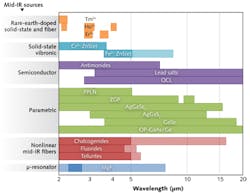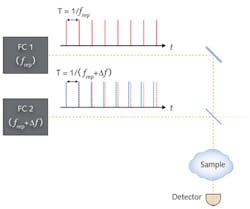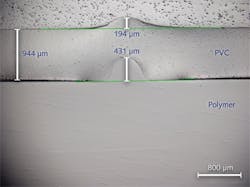CHARLES W. RUDY
The dramatic increase in availability of mid-infrared (mid-IR) light sources in the last several years can be largely attributed to the development of novel materials and the improving quality of traditional mid-IR materials. Typical sources of mid-IR radiation include solid-state lasers, fiber lasers, semiconductor lasers, and nonlinear optical devices with modes of operation from continuous wave (CW) to short pulse (see Fig. 1). Laser radiation in this spectral range allows for a host of novel applications to be explored, beginning one of the next great frontiers in laser science.
Nonlinear mid-IR sources
Nonlinear sources output mid-IR radiation through nonlinear frequency conversion of commonly available light sources. This nonlinear generation can take several forms, from conversion through parametric processes—including second-harmonic generation, difference-frequency generation, optical parametric amplifiers, and optical parametric oscillators—to spectral broadening of near-IR sources into the mid-IR through microresonators or supercontinuum generation (SCG).1 Nonlinear conversion to the mid-IR has been demonstrated with CW and pulsed sources. Since effective nonlinearity depends on peak intensity, ultrafast sources can greatly reduce average power thresholds for conversion.
Parametric generation can span much of the mid-IR spectral region using tunable or broadband pump sources. The possible wavelengths generated are limited by the pump sources and the nonlinear crystal (see Fig. 2). Commonly used nonlinear crystals, such as lithium niobate (transparent to 5 μm), do not allow for frequency conversion deep into the mid-IR region. For nonlinear conversion further into the mid-IR, materials with longer-wavelength transmission that incorporate gallium (Ga), arsenic (As), zinc (Zn), germanium (Ge), phosphorus (P), selenium (Se), or sulfur (S) such as GaAs, ZnGeP2, (Ag)GaSe(2), AgGaS2, or Ge can be used.In SCG, a high-intensity source (typically with femtosecond to nanosecond pulses) propagates through a nonlinear material and spectrally broadens due to four-wave mixing (FWM) and Raman scattering (energy transfer to longer wavelengths through scattering with optical phonons). Near-IR or short-wavelength mid-IR sources have been extended further into the mid-IR to ~5 μm through SCG in nonlinear materials with transparency in this region—typically optical fibers fabricated from fluorides, tellurites, and chalcogenides.2
Microresonators similarly broaden a pump source through FWM; however, the extremely high quality factor of these resonators allows for a CW source to create a broadband frequency comb with a pulsed output. Output wavelengths around 2.5 μm have recently been demonstrated.3 To increase the output wavelength, a longer-wavelength pump source can be used as long as coupling to and from the resonator can be established.
Semiconductor mid-IR lasers
Available in two varieties based on either intersubband transitions or interband transitions, mid-IR semiconductor lasers are both compact and electrically driven. Perhaps the more commercially developed of the two are those based on intersubband transitions; namely, quantum cascade lasers (QCLs).4
Engineering of the layered-material structure—commonly indium (In)-based InGaAs/InAlAs on InP—allows for the intersubband energy levels to be set such that the emission from an electronic transition is in the mid-IR region. While these QCLs can be structured to produce emission across much of the mid-IR range, CW room-temperature operation is difficult below 3 μm and above 11 μm. Individual QCLs can be tunable (limited to 500 cm-1 with pulsed operation) and emit more than 5 W of average power at ~5 μm. Pulsed QCLs in the mid-IR usually operate with pulse durations longer than 100 ns.
The structure of mid-IR sources based on interband transitions closely resemble double hetero-junction semiconductor lasers in more established wavelength ranges, where the active region has a lower bandgap and larger index of refraction than the surrounding material for carrier and photon confinement. The mid-IR interband semiconductor lasers are made using materials such as antimonides (GaInAsSb, InAsSb, InSb) and lead salts (PbSe, PbTe) that provide emission in the mid-IR due to their small bandgaps (< 0.6 eV).
Mid-IR fiber lasers
Fiber lasers have become ubiquitous over the last decade, largely due to a few key characteristics: high efficiency, compact packaging, superior reliability, excellent beam quality, and broad gain bandwidth. This has enabled fiber lasers to be used in applications covering industrial machining, medicine, and telecommunications.
There have been demonstrations of several mid-IR fiber lasers with trivalent rare earth ions like thulium (Tm), holmium (Ho), and erbium (Er), specifically Tm3+ (produces gain around 2.0 and 2.3 μm), Ho3+ (produces gain at about 2.1, 2.8, 3.0, 3.2, and 4.0 μm), and Er3+ (produces gain at ~2.9 and 3.5 μm).5
Telecommunications standard silica fibers have high mid-IR loss (> 2.7 μm) due to multiphonon absorption. So-called mid-IR glasses, including the fluorides, tellurites, and chalcogenides, have lower losses in this wavelength range due to lower phonon energies. Because of this, mid-IR fiber lasers beyond a wavelength of 2.1 μm typically use fluoride glasses like ZBLAN. Tellurite and chalcogenide fibers have mainly been used as mid-IR transport fibers or for spectral broadening.
For CW mid-IR fiber lasers, more than 1 kW of average output power has been achieved using Tm-doped silica fibers at 2 μm. As the wavelength of mid-IR sources increases linearly, the highest output power demonstrated decays exponentially, down to 10 mW for a 4 μm Ho-doped ZBLAN fiber laser. This is largely due to the increase in the quantum defect for longer-wavelength lasers, which greatly reduces the efficiency and creates complications due to heating. Recently, Raman scattering has been used to create quasi-CW chalcogenide fiber lasers at wavelengths beyond 3 μm with 50 mW of average power.6
Q-switched, gain switched, and mode-locked pulses have been generated by mid-IR fiber lasers. Most of these pulsed fiber laser sources operate in the 2 μm wavelength range, with sub-100 ns Q-switched Tm-doped fiber lasers reaching pulse energies beyond 2 mJ and mode-locked Tm-doped fiber lasers achieving 50 fs pulse durations as well as pulse energies above 100 μJ (for subpicosecond operation). Mode-locked 3 μm Er-doped ZBLAN fiber Q-switched sources have also been reported.7
Solid-state mid-IR lasers
Solid-state lasers in the mid-IR region were realized soon after the inception of the laser. In 1960, a 2.6 μm uranium (U)-based U3+:CaF2 flash-lamp-pumped solid-state laser was demonstrated. Most solid-state mid-IR lasers are now developed from electronic transitions in rare-earth ions and vibronic transitions (coupling between phonon and electronic states) in transition metals.
Several solid-state mid-IR lasers with trivalent rare-earth ions have been developed, with the most common dopants being Tm3+, Ho3+, and Er3+, with emission wavelengths similar to the rare-earth-doped fiber lasers. The host material can vary, but has a marginal effect on the emission spectrum of the dopant.
Vibronic sources in the mid-IR are perhaps more useful for several applications because they can provide much wider gain bandwidths than the rare-earth ions due to broadening caused by coupling between phonon and electronic states. IPG Photonics manufactures two such sources: a Cr2+:ZnS(e) laser often referred to as the Ti:sapphire of the mid-IR with emission from 2 to 3.5 μm, and a Fe2+:ZnS(e) laser with emission from ~3.5 to 5 μm.8,9 The IPG Birmingham, Alabama, location specializes in mid-IR transition-metal-doped ZnS(e) lasers, including tunable narrowband, nanosecond pulsed, and ultrafast mode-locked sources.
These binary as well as ternary (CdZnTe) gain media feature high emission cross-sections (~10–18 cm2), ultrabroadband emission spectra (up to 70% of central wavelength), convenient Er- and Tm-doped fiber laser pump sources, and the absence of excited-state absorption.10 Modifying the host material of a vibronic source causes a much larger change in the emission spectrum than in the case of the rare-earth ions due to the coupling between phonon and electronic states. This opens a pathway for crystal field engineering of transition-metal-doped II-VI ternary and quaternary semiconductors for mid-IR tunable lasing up to 8 mm.11, 12
At present, more than 20 W of power with high optical efficiency (up to 70%), wavelength tunability in excess of 1200 nm, and narrow spectral linewidth (<1 MHz) have been demonstrated for CW Cr2+:ZnS(e) lasers; pulsed sources from this material offer more than 1 J of pulse energy in long pulse operation (>100 μs) or 20 mJ for nanosecond pulse durations as well as pulse durations below 50 fs and peak power of 1 GW for mode-locked operation.For Fe2+:ZnS(e) lasers, more than 0.5 J of pulse energy in long pulse or 1 mJ for nanosecond pulse durations have been achieved. Arguably these lasers currently represent the simplest and the most cost-effective route for high-power, broadly tunable mid-IR lasing in the 2–5 μm wavelength range. These Cr2+:ZnS(e) and Fe2+:ZnS(e) crystals have even been used as saturable absorbers for mid-IR sources with emission within their respective absorption spectra.
Applications
An abundance of molecules have absorption features in this mid-IR "molecular fingerprint" region. Broadband sources, either tunable or pulsed, can cover a significant portion of the mid-IR region and identify multiple molecules in a single absorption spectroscopy test, making them highly useful for applications in biomolecular sensing, explosives detection, and environmental sensing.
Several methods of spectroscopy benefit from mid-IR sources, including 2D IR spectroscopy for investigating the behavior of molecular structures. In dual-comb spectroscopy, two stabilized pulsed sources provide broadband spectra composed of well-defined frequency lines (known as frequency combs) with slightly different spacing between their respective comb lines. The beating between the two combs shifts the measurement spectrum to radio frequency (RF), allowing for easier analysis with high resolution and sensitivity (see Fig. 3).By tuning the wavelength of the mid-IR source, the level of absorption can be varied significantly to fine-tune the machining process, and although this is being actively investigated, it is not yet apparent where the advantages may lie over using the well-established mid-IR CO2 laser technology. Wavelength tuning could also be used for material selective machining, where absorption in the target material is significantly higher than in a neighboring material.
Beyond spectroscopy and laser processing, remote sensing consists of emitting directional radiation towards a target and monitoring the reflected radiation to gain information about its appearance, location, speed, and composition. Originally developed in the RF domain, the imaging resolution of this technology can be improved by using optical frequencies. With single-transverse-mode operation, lasers also allow for superior directionality that improves the distance at which ranging can be performed. The ranging distance is increased further using a mid-IR wavelength where the atmosphere is relatively transparent (3–5 μm and 8–12 μm) and/or by scaling the average power of the source.
Additional mid-IR laser applications include particle acceleration and UV/X-ray pulse generation. For particle acceleration, the gradient of the accelerating field is greatly increased using optical rather than radio frequencies, reducing the accelerator length needed to reach desired electron energies. Particle acceleration in dielectric structures, which couple an electron beam and an accelerating optical field, has recently been demonstrated.13 To avoid direct absorption in future silicon dielectric structures (using a well-developed material system), the accelerating photons need to have lower energy than the bandgap of silicon (1.1 eV), which is possible using the longer wavelength of mid-IR lasers to eliminate direct absorption and reduce detrimental multiphoton absorption.
To generate extreme ultraviolet to soft X-ray attosecond pulses, typically near-IR high-peak-intensity (TW/mm2) radiation can be focused into a low-density gas in a process referred to as high harmonic generation (HHG).14 In gases, the highest harmonic that can be generated can be extended by increasing the wavelength of the driving source; hence the applicability of long-wavelength mid-IR lasers. And although HHG has been demonstrated in solids and the wavelength dependency no longer applies, mid-IR sources are still necessary to prevent catastrophic damage from absorption in the solid.
REFERENCES
1. M. Ebrahim-Zadeh and I. T. Sorokina, Mid-Infrared Coherent Sources and Applications (Springer, 2005).
2. C. W. Rudy, PhD Thesis, Stanford University (2013).
3. A. Schliesser et al., Nat. Photon. 6, 440-449 (2012).
4. I. T. Sorokina and K.L. Vodopyanov, Solid-State Mid-Infrared Sources (Springer, 2003)
5. S. D. Jackson, Nat. Photon., 6, 423–431 (2012).
6. M. Bernier et al., Opt. Lett., 38, 2, 127–129 (2013).
7. C. Wei, Opt. Lett., 37, 18, 3849–3851 (2012).
8. See http://www.ipgphotonics.com/Mid_ir_lasers.htm.
9. S. B. Mirov et al., Laser Photon. Rev., 4, 1, 21–41 (2010).
10. M. Mirov, OPN, 10, 26 (2013).
11. D. V. Martyshkin et al., SPIE Photonics West 2012, paper ITH5B.3, San Francisco, CA.
12. S. B. Mirov et al., J. Luminescence, 133, 268–275 (2013).
13. E. A. Peralta et al., Nature, 503, 91–94 (2013).
14. J. P. Marangos, Nat. Phys., 7, 97–98 (2011).
Charles W. Rudy is a laser scientist at IPG Photonics, Silicon Valley Technology Center, 3930 Freedom Circle, Suite 103, Santa Clara, CA 95054; e-mail: [email protected]; www.ipgphotonics.com.



